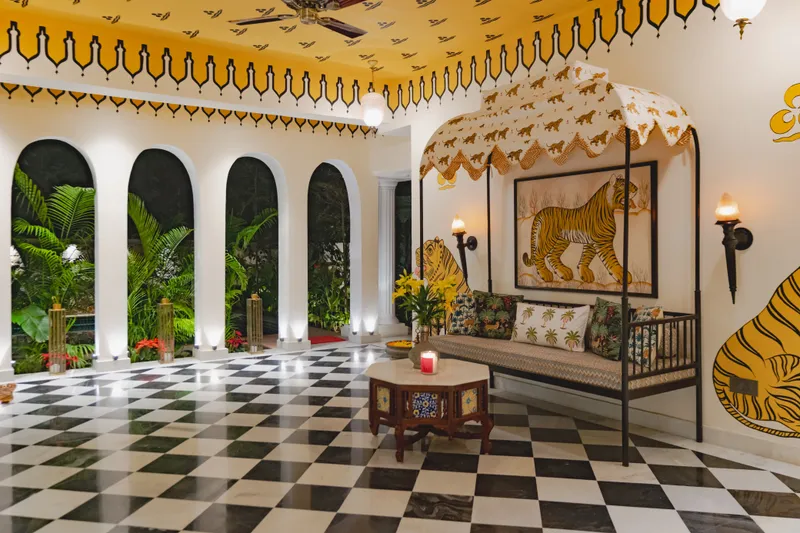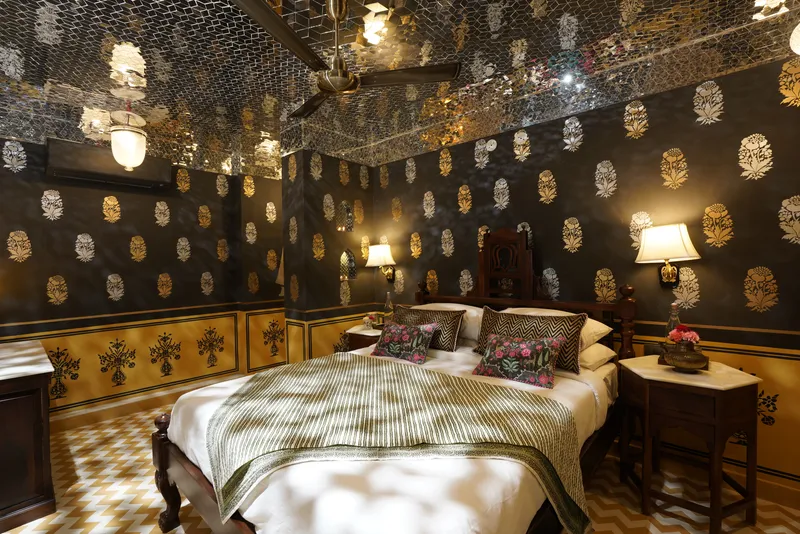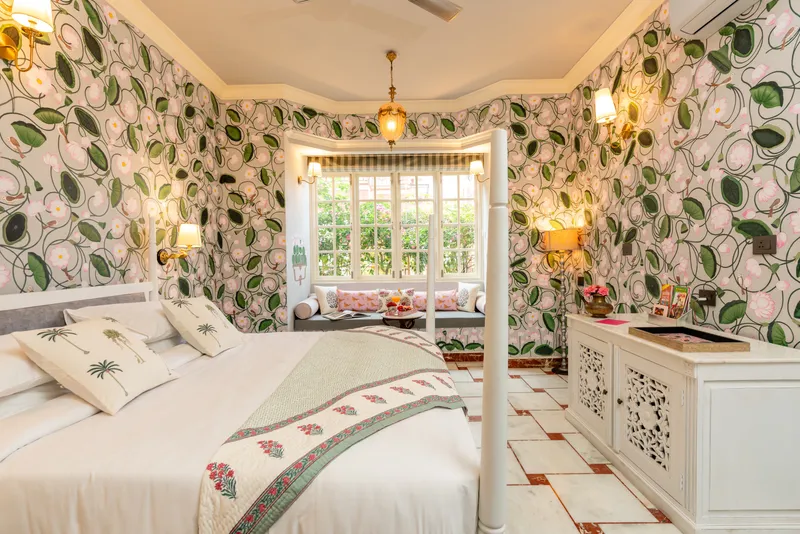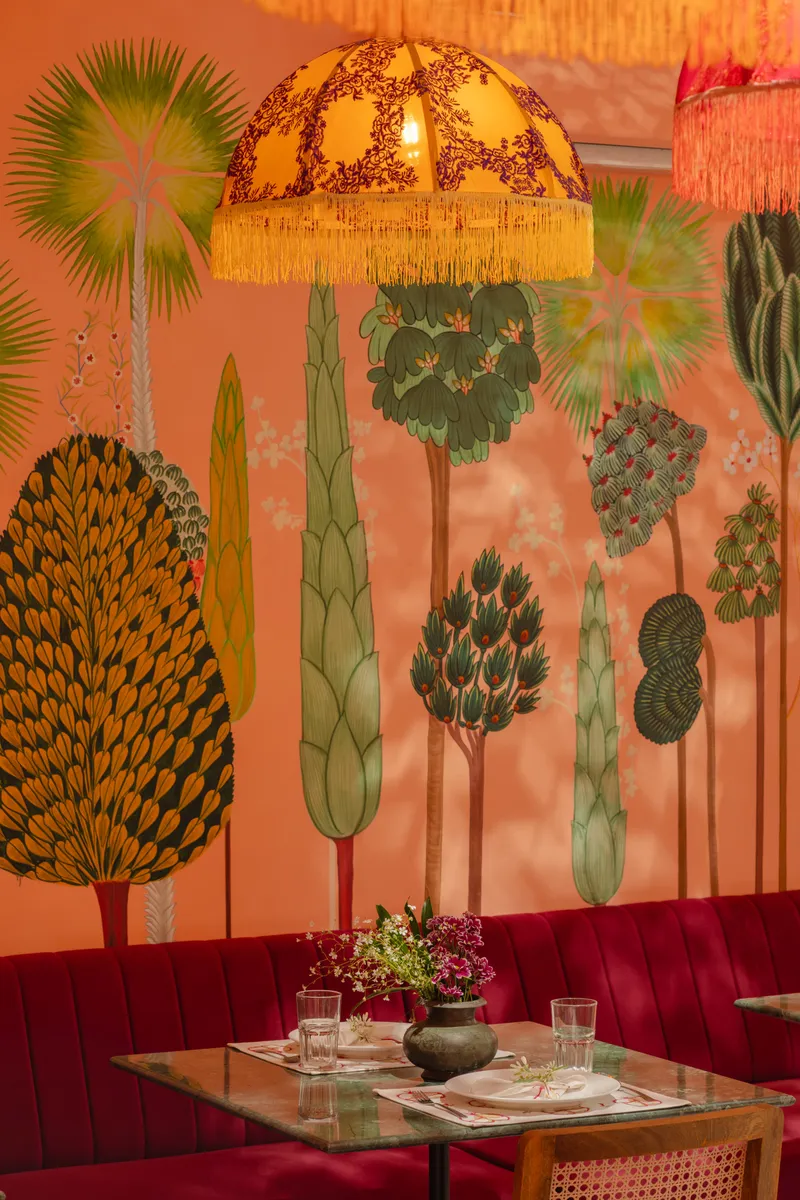Laalee in Jaipur is a celebration of local culture, cuisine and Krishna
Set in the plush neighbourhood of Gopalbari in Jaipur, this homestay is a glorious ode to Lord Krishna and the vibrant culture of Rajasthan.
Jaipur, often known as the ‘Pink City’, offers a smorgasbord of colours and cultures–not just through its magnificent forts and palaces but also its vibrant stories.
Dig a little deep and you will stumble upon hidden gems like Laalee–a true labour of love created by artist Shan Bhatnagar and his wife, Devyani, with the support of their friends Dr Preeti Kohli and Ganesh Kohli.
At first glance, the homestay, set in the city’s plush neighbourhood of Gopalbari, looks like just another pretty space. But once you make your way inside through the iron gate, you will be mesmerised by the singh dwar (gateway of lions or tigers) with five tigers painted on the wall, signifying protection and might.

The Singh Dwar has hand-painted tigers on the wall, protecting the gates of the beloved | Image: Sourabh Kaviya
Head a little further to explore a world that finds joy in the celebration of divinity.
Derived from the Hindi word lal, which means ‘scarlet’, Laalee represents Shan’s undying love for his muse–the beloved Lord Krishna. Each corner of the homestay depicts the artist’s longing for Lord Shrinathji, bringing forth different elements that mark the divinity’s journey.
“Lovingly, a mother calls her son ‘Lal’. Krishna would call Radha by the name ‘Laalee’. Even in Sufi tradition, it finds a mention in the song O Lal Meri Pat Rakhiyo Bala. Thus, the homestay is an amalgamation of many cultures,” says Shan.
How it all began
Both Devyani and Shan love hosting people. They’ve always had family and friends coming over to their home to experience the warmth of their hospitality.
Eight years ago, the couple decided to list their house (a stone’s throw away from Laalee) on Airbnb, where they also stay. The house–known as ‘Artist’s mansion in the Pink City’–has been carefully curated with antiques and curios bought over the years.
That’s where it all began.
“Our love for old-world charm has been an inherent part of our lives. I’ve decorated my own house and, subsequently, Laalee, with things that I have collected over the years. There’s everything–paintings, sculptures, art and antiques; all these things fascinate me,” says Shan.
During the Covid-19 pandemic, Devyani and Shan spotted the house where Laalee stands today. They fell in love with it and wanted to manifest their dream of having a homestay close to where they live.
As luck would have it, the space was on sale. With the help of their friends, the Kohlis (also their partners and investors), they began prepping up the space to welcome guests.
“Right after Ganesh and Dr Preeti bought the house in February last year, we began working on Laalee. In October, we had a soft launch, which was done in record time. I was around all the time, along with a big team that included artisans, masons, carpenters, electricians, plumbers and everyone else who deserves due credit,” recalls Shan.
“We had enough time to ease out the teething issues before opening Laalee to the world in January this year–right in time for the Jaipur Literature Festival,” adds Shan.
Hand-painted haven
As a painter, Shan draws inspiration from the Pichwai art of Rajasthan. Laalee, in its heart and soul, is a reflection of this tradition, which forms the centrepiece of every room in the homestay. Each room tells the story of Lord Krishna, an integral part of Pichwai art.
“I have used my favourite motifs for the Pichwais, which are essentially wall hangings that form a theatrical backdrop for the idol at Shrinathji temple in Nathdwara near Udaipur. These paintings tell you about the festival that’s going on, the time of the year, or the mood of the season,” says Shan.
Each of the seven rooms and two suites at Laalee has a name that goes with the theme it represents.
For instance, the Mayur room is bedecked with rare white peacocks, the plume of which was used by Lord Krishna for his shringar in summer. On the other hand, the Padma room sports hand-painted lotuses of the Yamuna river, while Basant depicts the flowers of spring. The Diwali room has mirror work and showcases a dark night in the hues of black, gold and silver.

The Diwali room is painted in hues of black, gold and silver | Image: Sourabh Kaviya
Then there’s the Gowdhuli room with motifs of cows and calves frolicking around. Gowdhuli connotes the time of the day when the sun is about to set and the cows come home. The dust that one sees at that hour is called gow dhul, informs Shan.
Utsav, as the name suggests, signifies celebration. It is inspired by the festival of Janmashtami and features motifs of marigolds, mango leaves, and banana trees– things that reflect festivity.
Sawan, of course, is all about welcoming the monsoon after the sultry summer.
The suites Jal and Sakrant also have beautiful stories to narrate.

The Padma room with hand painted lotuses | Image: Sourabh Kaviya
Jal has hand-painted cranes all over, meticulously created with a single hair brush with pigment paints. It symbolises the summer months when the Shrinathji temple at Nathdwara is filled with water from the Yamuna.
Sakrant, on the other hand, is inspired by the festival of Makar Sankranti, an important celebration for the people of Jaipur.
“The kitchen at Laalee moves up to the terrace, and Sankranti celebrations begin a month before the festival. There are colourful kites flying all over–it’s a sight to behold,” shares Shan.
It took about 400 to 500 human hours to hand-paint the motifs in each room. The Padma room, in particular, took 680 hours.
A culinary paradise
Food is an integral part of the Laalee experience. Though the homestay doesn’t serve meat, Devyani ensures her creativity comes alive through the vegetarian selection.
The Kayastha thali–a rich representation of the culinary heritage of the Kayastha community (that Devyani belongs to)–is popular among guests. It includes heirloom recipes such as arbi ki sabzi, kathal nihari, sukhi urad dal, and more.
“We do homestyle Rajasthani food that goes beyond the dal bati churma. Some of the dishes we make include sarson ke aloo and safed aloo cooked in dhania. There's also a kachri ki chutney made from a wild melon called kachri, indigenous to Rajasthan,” says Devyani, who believes her love for cooking comes from her nani (maternal grandmother) who could whip up anything from even simple ingredients.

The Kayastha Thali at Laalee | Image: Gourav Pathak
For those who want to learn the nuances of Kayastha cuisine, Devyani conducts classes at her house around the corner.
Laalee also offers world cuisine, inspired from the travels of the couple. The menu includes a Lebanese deconstructed chaat and jackfruit croquettes. And for those who love some street food, there are chaats from Uttar Pradesh and Rajasthan.
Besides this, Devyani and her sister-in-law run a cloud kitchen, Our Kitchen Fables, which began during the pandemic. It offers both vegetarian and non-vegetarian delicacies, including dawat-e-raan, junglee maas, and silbatta chicken curry.

Cafe Vrindavan | Image: Sourabh Kaviya
What else?
There’s a lot to do in and around Laalee. Start with chatting up Shan and Devyani, who know the ins and outs of Jaipur like no one else. Get their recommendations on eating out, shopping, and all the sights to savour.
One can book a walking tour with Shan inside the old city of Jaipur, a place he is most passionate about. The tour offers participants a peek into the hidden alcoves of Jaipur’s culture and food.
If there’s time in hand, one can also experience Laalee through the eyes of Shan, as he walks guests through the homestay, sharing fascinating nuggets about its various themes and everything that went on behind the scenes.
One can also unwind near the plunge pool, sip on coffee at Cafe Vrindavan within its premises, or enjoy me-time at the library lounge. The homestay plans to open another cafe in August that will have a wide selection of coffees and small bites.
In all, Laalee is bound to charm everyone with its myriad colours and flavours. It’s the perfect place to soak in stories of the past and also write one’s own.
Average cost for two per night: Rs 16,000 + taxes (includes breakfast and high tea)
Edited by Swetha Kannan







